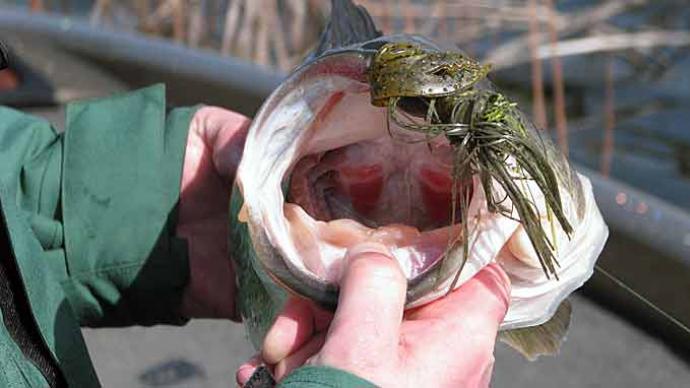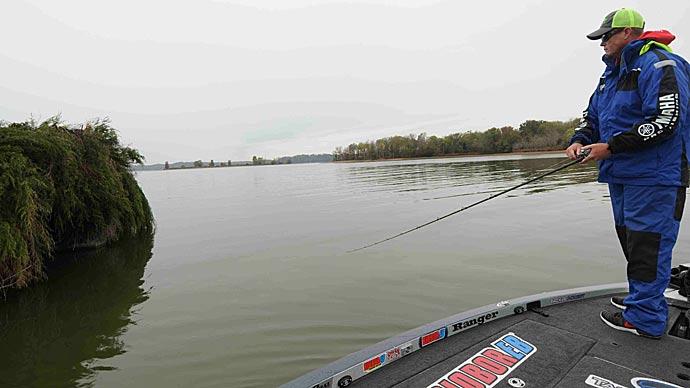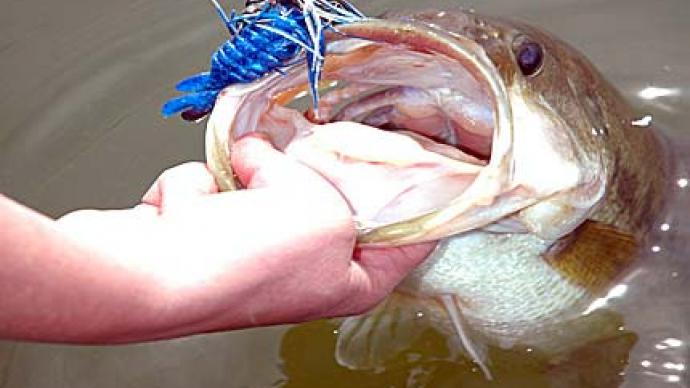
Seasoned largemouth bass anglers profess that for large bass throughout the seasons, a rubber or silicon-skirted jig with a pork or plastic trailer is hard to beat.
For that other "black bass", however, hair is the way to go. Smallmouth bass inhabiting most rivers in the Mid-Atlantic and Northeast prefer hair jigs to silicon or rubber skirted jigs, hands down. It has been a popular mistruth over the years that smallmouth do not eat or that they lay dormant when the water temperature holds in the 30's, as it does during the cold water winter period. The cold water period is an excellent time for anglers to catch trophy river smallmouth bass, and a hair jig is frequently the most productive lure.
Rubber and silicon jigs produce their share of smallmouth and work nicely, especially when targeting thick cover. Hair jigs are subtle, yet they heighten curiosity in smallmouth that are not tempted by other productive lures, including rubber jigs. Hair jigs come in various sizes, colors and styles. Bucktails, deer hair and marabou style jigs are productive on many game fish, especially smallmouth bass.

Don's Handcrafted Jigs makes a jig called the Millennium Jig. This jig is constructed from rabbit hair and top quality jig heads and is the choice for trophy cold water river bronze. When dropped into the water, the rabbit hair pulsates giving the lure an almost lifelike quality that will catch the attention of smallies even in water temperatures as cold as the mid 30's.
The key to fishing hair jigs effectively is the key to success with any other lure: Find the fish. A hair jig will produce as poorly as a rattling crankbait if fished in an area that isn't holding bass. Target eddies and related current break lines, mid-depth rocky flats and rocky drop offs adjacent to wintering holes for the most aggressive smallies during the cold water period. Rocky drop offs near winter holding areas that receive direct sunlight warm first on sunny days or during a warming trend. Smallmouth gravitate to these areas searching for a quick, big meal. Remember, they aren't inclined to expend much energy in cold water. Transitional bottom areas, or areas where a soft, sandy bottom merges with rock or ledges, are excellent feeding areas for winter smallmouth. Remember to fish any concrete or wood cover within the targeted area for less active bass. Smallmouth hold in these areas from the late fall period right through the cold water period and into early spring on many rivers.
Cast a hair jig to drop offs and structure near these feeding areas. Lift the rod tip until it is as high as your forehead. This allows the jig to fall straight and keeps the line tight. More aggressive bass may strike the jig while it is still falling immediately following the cast. Strikes can feel like mushy weight, similar to grass or a small stick. Or the strike may be a bit more evident, and a "tick" or "tap" will vibrate through the rod. Quality graphite rods like Quarrow's ML3 and ML4 series rods are important for this application. Set the hook hard if either of these conditions occur. Many anglers use the "I'm not sure if it's a fish" theory if the bite isn't obvious. That theory is good for loosing trophy smallmouth, so we'll stay away from it. We teach the "When in doubt, set the hook!" theory.
To work the jig, keep the rod tip high and the line tight and move the jig across the river floor or structure in a slow, deliberate manner. The jig shouldn't move more than several inches to a foot at a time. There is a time when swimming hair jigs is effective, when fish are chasing lures. That usually occurs when water temperatures are in the forties.
For cold smallies, slow and deliberate dragging, hopping or jigging is best. And when fish are extremely sluggish, as is the case much of the winter, the jig is effective when motionless on the river bottom. Remember, rabbit hair jigs create their own "life". Effective colors are black, olive and brown, although gray, tan and white will entice bass as well. Many jigs have combinations of several of the above colors. Jigs can be tipped with plastic or small pork trailers for more profile. Match the jig color with the trailer color for best results. Jigs can be thrown on medium action rods equipped with 6-10 pound McCoy Mean Green line.
River smallmouth bass provide tremendous fishing opportunities for beginning and advanced anglers twelve months per year. Hair jigs, especially Millennium Jigs from Don's Handcrafted Jigs, are excellent lures for fooling river smallmouth bass even when they reach their most inactive period during the winter. Find the fish holding areas and choose the best equipment for the job at hand. Remember to fish slowly and do not "overwork" the jig. The result of using hair jigs and following these simple rules can be quite satisfying.
Blaine is a freelance writer. Sponsors include Quarrow Rods, Don's handcrafted Jigs, Mizmo Bait Co., Odyssey Custom Jet Boats, Case Plastics and McCoy Line.




